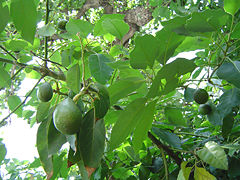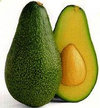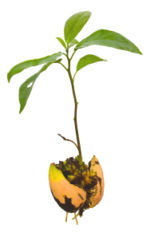Avocado
2008/9 Schools Wikipedia Selection. Related subjects: Food; Plants
| Avocado | ||||||||||||||
|---|---|---|---|---|---|---|---|---|---|---|---|---|---|---|
 Avocado fruit and foliage, Huntington Library, California
|
||||||||||||||
| Scientific classification | ||||||||||||||
|
||||||||||||||
| Binomial name | ||||||||||||||
| Persea americana Mill. |
The avocado (Persea americana) (from Nahuatl Aguacatl: agua-kah-tl), also known as aguacate, butter or alligator pear) is a tree native to Mexico, Central and northern South America, classified in the flowering plant family Lauraceae. The name "avocado" also refers to the fruit (technically a berry) of the tree that contains an egg-shaped pit. Avocado trees were cultivated in pre- Incan settlements with archeological evidence dating to 750 B.C.
Avocados are a commercially valuable crop whose trees and fruit are cultivated in tropical climates throughout the world, producing a green-skinned, pear-shaped fruit that ripens after harvesting. Trees are partially self-pollinating and often are propagated through grafting to maintain a predictable quality and quantity of the fruit.
Avocado fruits have a smooth, creamy, greenish-yellow flesh with an unusually high amount of fat that is primarily monounsaturated. They also contain a high concentration of dietary fibre, vitamins and potassium. The pit, seed, leaves, bark and in some cases fruit can be toxic to some animals, particularly birds, though much less so in humans; the toxicity of the fruit may be an adaptation that assisted seed dispersal by Pleistocene megafauna.
History
P. americana has a long history of being cultivated in Central and South America; a water jar shaped like an avocado, dating to A.D. 900, was discovered in the pre- Incan city of Chan Chan though there is evidence of cultivation in Mexico for as long as 10,000 years. The earliest known written account of the avocado in Europe is that of Martín Fernández de Enciso (c. 1470–c. 1528) in 1518 or 1519 in his book, Suma de Geografía que Trata de Todas las Partidas y Provincias del Mundo. The first written record in English of the use of the word 'avocado' was by Hans Sloane in a 1696 index of Jamaican plants. The plant was introduced to Indonesia by 1750, Brazil in 1809, the Levant in 1908, and South Africa and Australia in the late 19th century.
Etymology
The word "avocado" comes from the Nahuatl word ahuakatl (testicle, a reference to the shape of the fruit). Historically avocados had a long-standing stigma as a sexual stimulant and were not purchased or consumed by any person wishing to preserve a chaste image. Avocados were known by the Aztecs as "the fertility fruit". In some countries of South America such as Argentina, Bolivia, Chile, Peru, and Uruguay, the avocado is known by its Quechua name, palta. In other Spanish-speaking countries it is called aguacate, and in Portuguese it is abacate. The fruit is sometimes called a butter pear, avocado pear and alligator pear (pear due to its shape, and alligator due to the rough green skin of some cultivars). The Nahuatl ahuacatl can be compounded with other words, as in ahuacamolli, meaning "avocado soup or sauce", from which the Mexican Spanish word guacamole derives.
Cultivation
The tree grows to 20 metres (65 ft), with alternately arranged leaves 12–25 centimetres long. The flowers are inconspicuous, greenish-yellow, 5–10 millimetres wide. The pear-shaped fruit is 7 to 20 centimetres long, weighs between 100 and 1000 grams, and has a large central seed, 5 - 6.4 centimeters long. It is considered by many to be a drupe, but is botanically classified as a berry.
The subtropical species needs a climate without frost and with little wind. High winds reduce the humidity, dehydrate the flowers, and affect pollination. In particular, the West Indian race requires humidity and a tropical climate which is important in flowering. When even a mild frost occurs, some fruit may drop from the tree, reducing the yield, although the Hass cultivar can tolerate temperatures down to −1° C. The trees also need well aerated soils, ideally more than 1 m deep. Yield is reduced when the irrigation water is highly saline. These soil and climate conditions are provided only in a few areas of the world, particularly in southern Spain, the Levant, South Africa, Peru, parts of central and northern Chile, Vietnam, Indonesia, Sri Lanka, Australia, New Zealand, the United States, the Philippines, Malaysia, Central America, and Mexico, the centre of origin and diversity of this species. Each region has different types of cultivars. Mexico is the largest producer of the Hass variety, with over 1 million tonnes produced annually.
Harvest and post-harvest
An average avocado tree produces about 120 avocados annually. Commercial orchards produce an average of 7 tonnes per hectare each year, with some orchards achieving 20 tonnes per hectare. Biennial bearing can be a problem, with heavy crops in one year being followed by poor yields the next. The avocado tree does not tolerate freezing temperatures, and can be grown only in subtropical or tropical climates.
The avocado is a climacteric fruit (the banana is another), which means that it matures on the tree but ripens off the tree. Avocados used in commerce are picked hard and green and kept in coolers at 38 to 42°F (3.3 to 5.6°C) until they reach their final destination. Avocado must be mature to ripen properly. Avocados that fall off the tree ripen on the ground, and depending on the amount of oil they contain, their taste and texture may vary greatly. Generally, the fruit is picked once it reaches maturity; Mexican growers pick Hass-variety avocados when they have more than 23% dry matter and other producing countries have similar standards. Once picked, avocados ripen in a few days at room temperature (faster if stored with other fruits such as bananas, because of the influence of ethylene gas). Premium supermarkets sell pre-ripened avocados treated with synthetic ethylene to hasten the ripening process. In some cases, avocados can be left on the tree for several months, which is an advantage to commercial growers who seek the greatest return for their crop; if the fruit remains unpicked for too long, however, it will fall to the ground.
Breeding
The species is only partially able to self-pollinate, because of dichogamy in its flowering. This limitation, added to the long juvenile period, makes the species difficult to breed. Most cultivars are propagated via grafting, having originated from random seedling plants or minor mutations derived from cultivars. Modern breeding programs tend to use isolation plots where the chances of cross- pollination are reduced. That is the case for programs at the University of California, Riverside, as well as the Volcani Centre and the Instituto de Investigaciones Agropecuarias in Chile.
The avocado is unusual in that the timing of the male and female flower phases differs among cultivars. There are two flowering types, "A" and "B". "A" cultivar flowers open as female on the morning of the first day and close in late morning or early afternoon. Then they open as male in the afternoon of the second day. "B" varieties open as female on the afternoon of the first day, close in late afternoon and reopen as male the following morning.
- "A" cultivars: Hass, Gwen, Lamb Hass, Pinkerton, Reed.
- "B" cultivars: Fuerte, Sharwil, Zutano, Bacon, Ettinger, Sir Prize, Walter Hole.
Certain cultivars, such as the Hass, have a tendency to bear well only in alternate years. After a season with a low yield, due to factors such as cold (which the avocado does not tolerate well), the trees tend to produce abundantly the next season. This heavy crop depletes stored carbohydrates, resulting in a reduced yield the following season, and thus the alternate bearing pattern becomes established.
Propagation and rootstocks
While an avocado propagated by seed can bear fruit, it takes roughly 4–6 years to do so, and the offspring is unlikely to resemble the parent cultivar in fruit quality. Thus, commercial orchards are planted using grafted trees and rootstocks. Rootstocks are propagated by seed (seedling rootstocks) and also layering (clonal rootstocks). After about a year of growing the young plants in a greenhouse, they are ready to be grafted. Terminal and lateral grafting is normally used. The scion cultivar will then grow for another 6–12 months before the tree is ready to be sold. Clonal rootstocks have been selected for specific soil and disease conditions, such as poor soil aeration or resistance to the soil-borne disease caused by phytophthora (root rot).
Diseases
Avocado trees are vulnerable to bacterial, viral, fungal and nutritional diseases (excesses and deficiencies of key minerals). Disease can affect all parts of the plant, causing spotting, rotting, cankers, pitting and discoloration.
Cultivation in California
The avocado was introduced from Mexico to the U.S. state of California in the 19th century, and has become an extremely successful cash crop. Ninety-five percent of United States avocado production is located in southern California, with 60% in San Diego County. Approximately 59,000 acres (approximately 24,000 hectares) of avocados are grown in California. Fallbrook, California, claims the title of "Avocado Capital of the World", and both Fallbrook and Carpinteria, California host annual avocado festivals.
Hass cultivar
While dozens of cultivars are grown in California, the Hass avocado (commonly misspelled "Haas") is the most common. It produces fruit year-round and accounts for the majority of cultivated avocados in in California. All Hass avocado trees are genic copies of a single "mother tree" that was raised by a mail carrier named Rudolph Hass. According to Hass' family, Hass bought the seed from A.R. Rideout of Whittier, California, in 1926 and repeatedly attempted to graft productive branches onto pre-existing trees. Ultimately this succeeded in producing the Hass avocado, though the source tree of the graft is uncertain. Hass propagated the productive graft in his front yard in La Habra Heights, California, and patented the tree in 1935. All Hass avocados can be traced back to grafts made from the original, successful graft tree. The "mother tree" died of root rot and was cut down in September, 2002; its former location is indicated with a commemorative plaque.
Other cultivars
Other avocado cultivars include Bacon, Fuerte, Gwen, Pinkerton, Reed and Zutano. The fruit of the cultivar Florida, grown mostly outside California, is larger and rounder, with a smooth, medium-green skin, and a less-fatty, firmer and fibrous flesh. These are occasionally marketed as low-calorie avocados.
Avocado-related trade war

After the NAFTA treaty was signed, Mexico tried exporting avocados to the USA. The U.S. government resisted, claiming that the trade would introduce fruit flies that would destroy California's crops. The Mexican government responded by inviting U.S. Department of Agriculture inspectors to Mexico, but the U.S. government declined, claiming fruit fly inspection is not feasible. The Mexican government then proposed to sell avocados only to the northeastern U.S. in the winter (fruit flies cannot withstand extreme cold). The U.S. government balked, but gave in when the Mexican government started throwing up barriers to U.S. American corn.
Legitimate pest invasion issues exist, as avocado pests originating in Mexico have made their way to California, including the persea mite and avocado thrips. These pests have increased pest control costs and made previously-relied-upon biological control less feasible. Other potentially disastrous pests, including a weevil, remain risks. Another argument is that the lower prices generated by the Mexican and Chilean imports would increase the popularity of avocados outside of California, thereby assuaging the loss of profits due to the new competition.
Today avocados from Mexico are allowed in all 50 states. This is because USDA inspectors in Uruapan, Michoacán (the state where 90% of Hass avocados from Mexico are grown), have cut open and inspected millions of fruit, finding no problems. Imports from Mexico in the 2005-2006 season exceeded 130,000 tonnes.
Avocados are more expensive in the USA than in other countries, because those consumed in the USA are grown almost exclusively in California and Florida. California produces about 90% of the nation's avocado crop.
Uses
| Avocado, raw (edible parts) Nutritional value per 100 g (3.5 oz) |
|||||||||||||||||||||||||||||||||||||
|---|---|---|---|---|---|---|---|---|---|---|---|---|---|---|---|---|---|---|---|---|---|---|---|---|---|---|---|---|---|---|---|---|---|---|---|---|---|
| Energy 160 kcal 670 kJ | |||||||||||||||||||||||||||||||||||||
|
|||||||||||||||||||||||||||||||||||||
| Percentages are relative to US recommendations for adults. Source: USDA Nutrient database |
|||||||||||||||||||||||||||||||||||||
The fruit of horticultural cultivars ranges from more or less round to egg- or pear-shaped, typically the size of a temperate-zone pear or larger, on the outside bright green to green-brown (or almost black) in colour. The fruit has a markedly higher fat content than most other fruit, mostly monounsaturated fat. A ripe avocado will yield to a gentle pressure when held in the palm of the hand and squeezed. The flesh is typically greenish yellow to golden yellow when ripe. The flesh oxidizes and turns brown quickly after exposure to air. To prevent this, lime or lemon juice can be added to avocados after they are peeled.
The avocado is very popular in vegetarian cuisine, making an excellent substitute for meats in sandwiches and salads because of its high fat content. The fruit is not sweet, but fatty, distinctly yet subtly flavored, and of smooth, almost creamy texture. It is used as the base for the Mexican dip known as guacamole, as well as a filling for several kinds of sushi, including California rolls. Avocado is popular in chicken dishes and as a spread on toast, served with salt and pepper. In Brazil and Vietnam, avocados are considered sweet fruits, so are frequently used for milk-shakes and occasionally added to ice cream and other desserts. In Brazil, Vietnam, the Philippines and Indonesia, a dessert drink is made with sugar, milk or water, and pureed avocado. Chocolate syrup is sometimes added.
In Mexico and Central America, avocados are served mixed with white rice, in soups, salads, or on the side of chicken and meat. In Chile its consumption is widespread and used as a puree in chicken, hamburgers and hot dogs, and in slices for celery or lettuce salads. The Chilean version of caesar salad contains large slices of mature avocado.
Nutritional value
A whole medium avocado contains approximately 21 grams of fat, though most of it is monounsaturated fat. Avocados also have 60% more potassium than bananas. They are rich in B vitamins, as well as vitamin E and vitamin K. They have the highest fiber content of any fruit - including 75% insoluble and 25% soluble fibre.
A fatty triol ( fatty alcohol) with one double bond, avocadene (16-heptadecene-1,2,4-triol), is found in avocado.
As a houseplant
Avocado can be grown as a houseplant from seed. It can germinate in normal soil in a large pot or by suspending a washed pit (generally using toothpicks embedded in the sides) pointed-side up and filling the glass until the bottom quarter of the pit is covered. The pit will crack as it absorbs water and germinates, and should sprout in 4–6 weeks. When the roots and stem emerge from the seed, it can be planted in soil. The young tree is amenable to pruning and training but will not normally bear fruit indoors without sufficient sunlight and a second plant to cross-pollinate.
Toxicity to animals
There is documented evidence that animals such as cats, dogs, cattle, goats, rabbits, birds, fish and particularly, horses can be severely harmed or even killed when they consume the avocado leaves, bark, skin, or pit. The avocado fruit is poisonous to birds in some cases, so on a practical level feeding the fruit to birds should be avoided. Avocado leaves contain a toxic fatty acid derivative known as persin, which in sufficient quantity can cause equine colic and, with lack of veterinary treatment, death. The symptoms include gastrointestinal irritation, vomiting, diarrhea, respiratory distress, congestion, fluid accumulation around the tissues of the heart and even death. Birds also seem to be particularly sensitive to this toxic compound. Negative effects in humans seem to be primarily in allergic individuals.
Co-evolution
The avocado may be an example of an 'evolutionary anachronism', a fruit adapted for ecological relationship with now-extinct large mammals (such as the giant ground sloth or the Gomphothere). Most large fleshy fruits serve the function of seed dispersal, accomplished by their consumption by large animals. Author Connie Barlow hypothesizes that the fruit, with its mildly toxic pit, may have co-evolved with Pleistocene megafauna to be swallowed whole and excreted in their dung, ready to sprout. No extant native animal is large enough to effectively disperse avocado seeds in this fashion. When the avocado's hypothesized ecological partners disappeared the avocado likely would have gone extinct, or evolved a different fruit morphology, if human cultivation had not maintained this "ghost of evolution."




